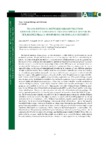Por favor, use este identificador para citar o enlazar este ítem:
http://www.alice.cnptia.embrapa.br/alice/handle/doc/868527Registro completo de metadatos
| Campo DC | Valor | Lengua/Idioma |
|---|---|---|
| dc.contributor.author | GIACHETTO, P. F. | pt_BR |
| dc.contributor.author | YAMAGISHI, M. E. B. | pt_BR |
| dc.contributor.author | SANTOS, E. H. dos | pt_BR |
| dc.contributor.author | IBELLI, A. M. G. | pt_BR |
| dc.contributor.author | REGITANO, L. C. de A. | pt_BR |
| dc.date.accessioned | 2011-04-09T17:49:37Z | - |
| dc.date.available | 2011-04-09T17:49:37Z | - |
| dc.date.created | 2010-12-02 | pt_BR |
| dc.date.issued | 2010 | pt_BR |
| dc.identifier.citation | In: INTERNATIONAL CONFERENCE OF THE BRAZILIAN ASSOCIATION FOR BIOINFORMATICS AND COMPUTATIONAL BIOLOGY, 6., 2010, Ouro Preto. Abstracts... [S.l.: s.n.], 2010. | pt_BR |
| dc.identifier.uri | http://www.alice.cnptia.embrapa.br/alice/handle/doc/868527 | pt_BR |
| dc.description | In tropical countries, losses caused by tick infestation in cattle lead to a great impact on animal production systems. Weight and feed conversion reduction, together with diseases transmitted by the parasite are some of the problems that lead to economic losses of billion dollars a year. In a general way, Bos taurus indicus cattle are less susceptible to infestation with Rhipicephalus (Boophilus) microplus than Bos taurus taurus cattle but the immunological basis of this difference is not understood. Since we are interested in finding genes that may be involved in mechanism of bovine response to tick for use in animal breeding, we investigated transcriptional networks in the response of these different genotypes of cattle to tick infestation. Recent studies show that co-expression networks can be used to identify a set of candidate genes underlying specific phenotypes and some gene co-expression network methods have been successfully applied in a variety of studies. In this study, Weighted Gene Co-expression Network Analysis (WGCNA) was applied, using microarray expression data. This systems biology analysis method starts out by identification of modules of genes based on patterns of gene co-expression, defined as sets of highly correlated (connected) genes, which may represent molecular networks involved in a common biological pathway. Genes highly connected within these modules are thought to drive the group, and are considered to be hub genes . Skin samples were collected from bovines of different genotypes before (BI) and after (AI) artificial tick infestation and mRNA used for GeneChip Bovine Genome Array hybridization. Microarray data were processed using affy /Bioconductor software package. We follow a general framework for constructing gene co-expression networks and used the WGCNA R package. The power adjacency function was applied to the co-expression measurement, the absolute Pearson correlation coefficient, to derive the adjacency matrix; we used a soft thresholding approach by raising each correlation to a fixed power (?=6). Modules were defined using the dynamic hybrid tree cutting algorithm of the dynamicTreeCut R package. Our analysis identified 8 modules. Each of the modules was labeled with a unique color as an identifier and characterized for enrichment of functionally-related genes. Interesting modules were defined as those enriched with genes involved in immune response and containing differentialy expressed genes (DEG), wigh were identified separately in each module. The blue module (n=220 genes) was enriched for genes belonging to Chemokine signaling pathway , Focal adhesion and Cell adhesion molecules pathways, and had the greatest number of DEG. These DEG, together with the hub genes inside the blue module are candidate genes elected for further studies aiming the understanding of mechanisms involved in tick tolerance by cattle. Supported by: Embrapa, CNPq. | pt_BR |
| dc.language.iso | eng | eng |
| dc.rights | openAccess | eng |
| dc.subject | Dados de microarranjos | pt_BR |
| dc.title | Transcriptional networks reconstruction: identification of genes involved on cattle response to tick Rhipicephalus (Boophilus) microplus infestation. | pt_BR |
| dc.type | Resumo em anais e proceedings | pt_BR |
| dc.date.updated | 2020-01-27T11:11:11Z | pt_BR |
| dc.subject.thesagro | Genética Animal | pt_BR |
| dc.subject.thesagro | Gado | pt_BR |
| dc.subject.nalthesaurus | Rhipicephalus microplus | pt_BR |
| dc.subject.nalthesaurus | Animal genetics | pt_BR |
| dc.description.notes | Na publicação: Regitano, L.C.A. X-meeting 2010. | pt_BR |
| dc.format.extent2 | p. 154. | pt_BR |
| riaa.ainfo.id | 868527 | pt_BR |
| riaa.ainfo.lastupdate | 2020-01-27 -02:00:00 | pt_BR |
| dc.contributor.institution | POLIANA FERNANDA GIACHETTO, CNPTIA | pt_BR |
| dc.contributor.institution | MICHEL EDUARDO BELEZA YAMAGISHI, CNPTIA | eng |
| dc.contributor.institution | EDGARD HENRIQUE DOS SANTOS, CNPTIA | eng |
| dc.contributor.institution | ADRIANA MERCIA GUARATINI IBELLI, CPPSE | eng |
| dc.contributor.institution | LUCIANA CORREIA DE ALMEIDA REGITANO, CPPSE. | eng |
| Aparece en las colecciones: | Resumo em anais de congresso (CNPTIA)  | |
Ficheros en este ítem:
| Fichero | Descripción | Tamaño | Formato | |
|---|---|---|---|---|
| p154out.pdf | 1,23 MB | Adobe PDF |  Visualizar/Abrir |









